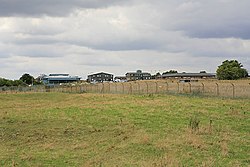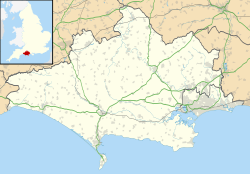Blandford Camp
| Blandford Camp | |
|---|---|
| Near Blandford Forum, Dorset in England | |

Part of Blandford Camp seen from a nearby tumulus
|
|
|
Shown within Dorset
|
|
| Coordinates | 50°52′N 2°07′W / 50.867°N 2.117°WCoordinates: 50°52′N 2°07′W / 50.867°N 2.117°W |
| Type | Army base |
| Site information | |
| Owner | Ministry of Defence |
| Operator | British Army |
| Controlled by | Royal Signals |
| Site history | |
| Built | 1724 |
| In use | 1724-present |

A view just outside the circuit, which crosses from the blue fence on the right beyond the hedge and through where the gate now stands in the centre. This point on the track was called "The Dip"
|
|
| Location | Dorset, England |
|---|---|
| Time zone | GMT |
| Opened | 25 July 1948 |
| Closed | ? |
| Major events |
Formula Two Road Racing Motorcycle Racing |
| Length | 5.05 km (3.14 mi) |
| Turns | 6 |
Blandford Camp is a military base comprising some 390 hectares of downland lying 2 miles (3 km) north-east of Blandford Forum in the county of Dorset in southern England.
Significant areas of the camp are Sites of Special Scientific Interest (SSSI).
Blandford Camp is currently the home of the Royal Signals, housing both the headquarters of the corps as well as the headquarters of the Defence College of Communications and Information Systems (DCCIS), the Royal School of Signals (which includes 11 Signal Regiment), and the Royal Signals Museum. A number of other telecommunications-related units, such as the MOD Land Systems Reference Centre, are also housed on the site. Over the years, however, the camp has been home to Royal Navy, Royal Air Force, Army and joint-Service units, as well as to a US Army hospital complex. The site has also been used as a road racing circuit.
There are numerous prehistoric sites within the camp boundaries, but the first recorded use of the site was as a racecourse, giving rise to the naming of part of the area as Race Down. Race meetings began in the late 16th century and an annual race week was held until the end of the 19th century.
It is thought that the area has been used by military forces for many centuries but the first definite use of the site was in the 18th century when local volunteer units used it as a training ground. In addition, in 1724 a troop of the Hussars were stationed in the area for anti-smuggling duties.
...
Wikipedia

